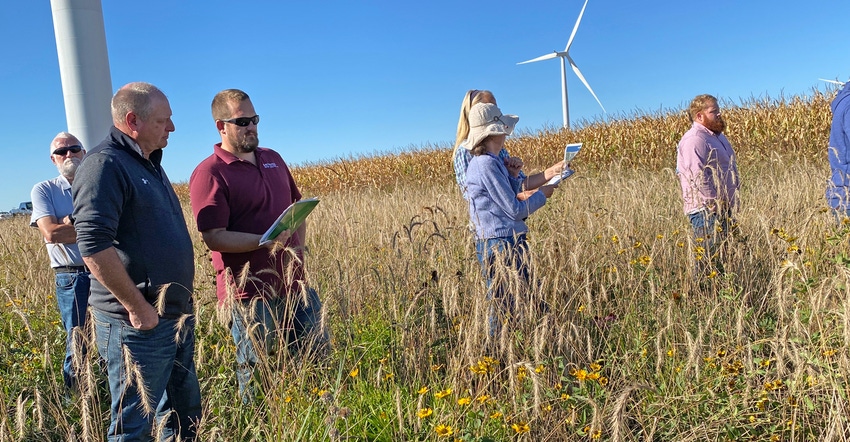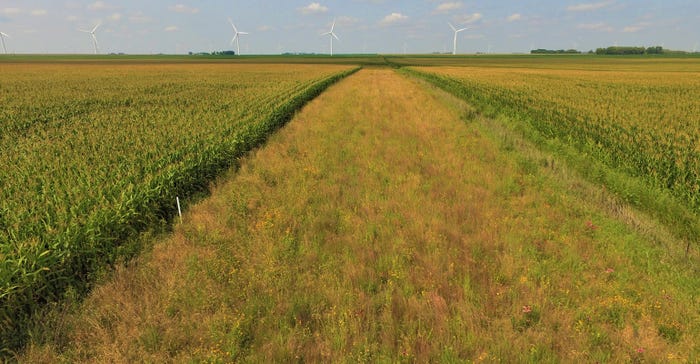November 18, 2021

After a big rain, Wayne DeWall would see soil from his Mower County, Minn., cropland washing away in the headwaters of the Root River’s south branch.
In recent years, though, that has changed where DeWall has established sections of native vegetation called “prairie strips” in strategic spots of his cropland south of Grand Meadow. With those in place, he has seen a difference.
“Sometimes when you get a bigger rain event, you’ll have soil get trapped right in the edges of the prairie strip there,” DeWall says. “But that’s as far as it goes, basically, which is exactly what we wanted — and that’s good to see it actually working.”
 HIGHER VIEW: This view of Wayne DeWall’s prairie strip was captured by a drone.
HIGHER VIEW: This view of Wayne DeWall’s prairie strip was captured by a drone.

Prairie strips are a way to conserve soil, improve water quality and provide habitat for wildlife and pollinators. Ranging from 30 to 120 feet in width, prairie strips are highly effective at reducing the loss of sediment, nutrients and pesticides when stormwater runs off cropland.
Farmers and landowners can sign up to establish prairie strips through the federal Conservation Reserve Program under a 10- or 15-year conservation contract that keeps those acres from being used for cropland. CRP provides landowners with $258 to $300 per acre annually under its prairie-strip program, with most of the costs covered through cost-share assistance for preparing the site, buying seed, seeding the land and establishing the practice.
“This is the most-flexible set-aside land program in more than 30 years,” says James Fett, watershed technician for Mower Soil and Water Conservation District. With this specific CRP program, farmers can drive equipment on the strips, which is not allowed in most other CRP programs.
Farmers enrolling in the program have used crop-yield records as a planning tool to place prairie strips in areas that make CRP more profitable than farming those acres, Fett says. Prairie strips are beneficial for landowners enrolling acres on their headlands, where machinery runs over soil the most.
Although the next CRP sign-up deadline for this is a year away, Justin Hanson, Mower SWCD district manager, says that now is a good time for farmers to look into the option with SWCD and USDA Natural Resources Conservation Service staff because harvest is finished, and yield monitors can show which areas might be good for prairie strips.
“Typically, yield monitors drop off a bit when they get into headlands or other marginal areas,” Hanson says. “We are encouraging farmers to be thinking about CRP alternatives when they see those numbers drop off.”
Prairie strip benefits
More than 10 years of research has shown that prairie strips can yield strong benefits for reducing excess amounts of sediment, nutrients and pesticides in stormwater runoff when integrated in small amounts into strategic spots in corn and soybean fields. Iowa State University research shows planting dense, diverse and deeply rooted strips of prairie next to corn and soybean fields has environmental benefits. These small amounts of prairie come in the form of in-field, contour buffer strips and edge-of-field filter strips.
Prairie strips provide strong benefits to a greater degree than other types of perennial vegetation because they incorporate a diverse array of native plant species with deep, multilayered root systems and stiff stems that hold up during runoff from a driving rain. Prairie mixes have a high density of flowers that promote pollinators and look colorful throughout spring, summer and fall, too.
DeWall has been pleased with what he has seen growing in his prairie strips.
“I’m very happy,” he says. “We’ve got lots of native grasses, lots of flowers. It’s exactly what we were looking for when we started this. It took a few years to get to this point, so you just have to be patient with it.”
DeWall’s prairie strip was implemented as part of the Minnesota Department of Agriculture’s Root River Field to Stream Partnership program, with partners closely monitoring and measuring each stormwater runoff event at the site. Prior to the prairie strip, the partnership gathered six years of data at the site. Early results show immediate water-quality improvements due to the prairie strip at the DeWall farm. Fett collects stormwater runoff samples from a monitoring site next to DeWall’s prairie strip as part of the field to stream partnership.
ISU’s STRIPS (Science-based Trials of Rowcrops Integrated with Prairie Strips) team has done research on prairie strips for more than a decade, and found that integrating small amounts of prairie into strategic locations in corn and soybean fields — in-field contour buffer strips and edge-of-field filter strips — can yield significant benefits for soil, water and biodiversity. Better benefits than perennial vegetation are due to the diversity of native plant species incorporated with prairie strips. Their deep and multilayered root systems and stiff stems hold up in a driving rain.
Learn more by watching a YouTube video of Fett and DeWall discussing prairie strips at bit.ly/prairiestrips. For more information about prairie strips, contact the Mower SWCD at 507-434-2603 or visit its website, mowerswcd.org
Editor Paula Mohr added to this report.
Source: Mower SWCD, which is solely responsible for the information provided and is wholly owned by the source. Informa Business Media and all of its subsidiaries are not responsible for any of the content contained in this information asset.
You May Also Like




